The HPM Applied to MHD Nanofluid Flow over a Horizontal Stretching Plate
Abstract
The nonlinear two-dimensional forced-convection boundary-layer magneto hydrodynamic (MHD) incompressible flow of nanofluid over a horizontal stretching flat plate with variable magnetic field including the viscous dissipation effect is solved using the homotopy perturbation method (HPM). In the present work, our results of the HPM are compared with the results of simulation using the finite difference method, Keller′s box-scheme. The comparisons of the results show that the HPM has the capability of solving the nonlinear boundary layer MHD flow of nanofluid with sufficient accuracy.
1. Introduction
Recently, lots of attention are devoted toward the semianalytical solution of real-life mathematical modeling that is inherently nonlinear differential equations with variable coefficients. Most of the nonlinear differential equations do not have an analytical solution. However, so far there have been many researchers that attempted to solve the nonlinear differential equations by using numeric methods. Using the numeric methods, a tremendous amount of CPU time as well as huge memory is required. Semianalytical methods which are more suitable than the numerical methods are applied for the solution of nonlinear nonhomogeneous partial differential equations [1–7]. Comparing with other methods, the Semianalytical methods have the advantage of simplicity when applying to solve complicated nonlinear problems. The HPM, ADM, and VIM methods are used to solve the nonhomogeneous variable coefficient partial differential equations with accurate approximation. Consequently, to extend the validity of the solution to a broader range, one needs to handle huge amount of computational effort. The most powerful Semianalytical method to the solution of nonhomogeneous variable coefficient partial differential equations is the homotopy perturbation method (HPM).
He [8–12] developed the homotopy perturbation method for solving linear, nonlinear, and initial and boundary value problems by combining the standard homotopy and the perturbation methods. The homotopy perturbation method was formulated by taking the full advantage of the standard homotopy and perturbation methods and has been modified later by some scientists to obtain more accurate results, rapid convergence, and to reduce the amount of computation [13–16].
Recently, some of researchers have solved many problems in different fields of engineering. Singh et al. [17] solved space-time fractional solidification in a finite slab with HPM. Ajadi and Zuilino [18] applied HPM to reaction-diffusion equations with source term. They concluded that rapid convergence is obtained to the exact solution by HPM. Slota [19] applied the HPM to Stefan solidification heat equation problem, and his results show that HPM is a capable method for solving the problems under consideration.
The basic motivation of this paper is to solve a two-dimensional forced-convection boundary-layer MHD problem formed by a magneto hydrodynamic (MHD) incompressible nanofluid flow in the presence of variable magnetic field over a horizontal flat plate including the viscous dissipation term using the HPM. The two-dimensional forced-convection boundary-layer MHD problem is also simulated with the numerical Keller’s box-scheme [20], and the results of simulation are compared with the results obtained by solving the problem using the HPM. In the present problem, a nanoincompressible fluid in the presence of a variable magnetic field and the viscous dissipation effect over a horizontal stretching flat plate are considered. The results are compared with the previous results of numerical simulation. To our knowledge, there have been no results reported so far for the boundary layer flow of nanofluid, using the HPM method, including the MHD with variable magnetic field, and viscous dissipation effect.
2. Basic Idea of Homotopy Perturbation Method
3. Mathematical Formulation
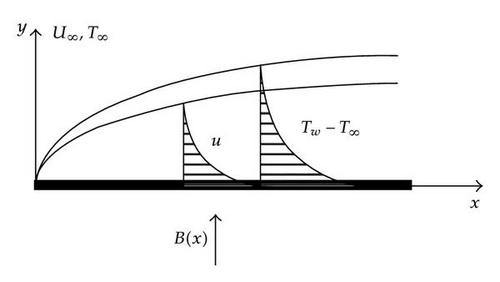
4. The HPM Applied to the Problem
These functions, f and θ, are calculated for the case where, Ec = 0.1, m = 0, Pr = 6.2, φ = 0.2, and Mn = 0.2. The physical properties of the fluid, water, and the nanoparticles, aluminum oxide (Al2O3), are given in Table 1.
| Physical properties | Fluid (water) | Nanoparticles Al2O3 |
|---|---|---|
| ρ (kg m−3) | 997.1 | 3970 |
| Cp (J kg−1 K−1) | 4179 | 765 |
| k (W m−1 K−1) | 0.613 | 40 |
5. Numerical Method
The differential equations, (3.13) and (3.14), along with the boundary conditions, (3.15), are split into five first-order differential equations by introducing new dependent variables. The five split first-order differential equations are discretized using the first-order backward finite difference scheme, the so-called Keller’s box method [20]. The discretized form of the five split differential equations are linearized using the Newton’s method [24–26]. The discretized and linearized equations form a system of block-tridiagonal equations which are solved using the block-tridiagonal-elimination technique [26]. A step size of Δη = 0.005 is selected to satisfy the convergence criterion of 10−4 in all cases. In our simulation, η∞ is chosen to be equal to 5 in order to suffice for taking into account the full effect of boundary layer growth. Then the differential equations, (3.13) and (3.14), along with the boundary conditions, (3.15), are solved using the HPM. The recursive differential equations with the relevant boundary conditions resulting from the HPM are solved using the MAPLE software.
6. Results and Discussions
Table 2 shows the comparison between the results obtained from HPM and the results obtained from the numerical method (NM) at Ec = 0.1, m = 0, Pr = 6.2, φ = 0.2, and Mn = 0.2. The comparison of the results obtained from the HPM and the results obtained from the NM shows excellent agreements at different values of the similarity parameter. Figure 2 shows the comparison of dimensionless velocity profiles versus the normalized coordinates using the Keller’s box numerical method with the results obtained by the HPM at Ec = 0.1, m = 0, Pr = 6.2, φ = 0.2, and Mn = 0.2. The results obtained from the HPM are reported for three different sums of terms, S = 4, 8, and 12, in the HPM series solution. It is obvious from Figure 2 that as the number of sums of terms in the HPM series solution increases, the results approach towards the profile obtained from the NM. The mean discrepancies between the results of velocity obtained from the HPM for S = 12 and the results obtained from the NM are at most 2%. Figure 3 shows the comparison of dimensionless temperature profiles versus the normalized coordinates using the Keller’s box numerical method with the results obtained by the HPM at Ec = 0.1, m = 0, Pr = 6.2, φ = 0.2, and Mn = 0.2. The results obtained from the HPM are reported for three different sums of terms, S = 4, 8, and 12, in the HPM series solution. As the number of sums of terms in the HPM series solution increases the agreement between the results obtained from the HPM and the results obtained from the NM is more pronounced. The mean discrepancies between the results of temperature obtained from the HPM for S = 12 and the results obtained from the NM are less than 5%. Figure 4 shows the comparison of dimensionless velocity profiles versus the normalized coordinates using the Keller’s box numerical method with the results obtained by the HPM at Ec = 0.1, m = 0, Pr = 6.2, φ = 0.2, and Mn = 0. The results obtained from the HPM are reported for three different number of sums of terms, S = 4, 8, and 12, in the HPM series solution. As the number of sums of terms in the HPM series solution increases the agreement between the results of dimensionless velocity obtained from the HPM and the results obtained from the NM is more pronounced. The results of velocity obtained from the HPM for S = 8 and 12 and the results obtained from the NM are almost the same. Figure 5 shows the comparison of dimensionless temperature profiles versus the normalized coordinates using the Keller’s box numerical method with the results obtained by the HPM at Ec = 0.1, m = 0, Pr = 6.2, φ = 0.2, and Mn = 0. The results obtained from the HPM are reported for three different sums of terms, S = 4, 8, and 12, in the HPM series solution. However, as the number of sums of terms in the HPM series solution increases, the agreement between the results obtained from the HPM and the results obtained from the NM is more apparent. For the temperature profiles, the mean discrepancies between the results obtained from the HPM when S = 12 and the results obtained from the NM are at most 8%, whereas the discrepancies between the results obtained for velocity from HPM and NM are negligible at the same conditions. The reason of this behavior is due to the complex nonlinearity that exists in the nature of the governing equations which makes it so difficult to exactly realize the obsessive interaction existing in the problem. Figure 6 shows the comparison between dimensionless velocity profiles versus the normalized coordinates using the Keller’s box numerical method and the results obtained by the HPM at Ec = 0, m = 0, Pr = 6.2, φ = 0.2, and Mn = 0.2. The results obtained from the HPM are reported for three different sums of terms S = 4, 8, and 12 in the HPM series solution. Figure 7 shows the comparison of dimensionless temperature profiles versus the normalized coordinates using the Keller’s box numerical method with the results obtained by the HPM at Ec = 0.1, m = 0, Pr = 6.2, φ = 0.2, and Mn = 0.2. The results obtained from the HPM are reported for three different sums of terms, S = 4, 8, and 12, in the HPM series solution. It is obvious that as the number of sums of terms in the HPM series solution increases, the results approach toward the profile obtained from the NM. The mean discrepancies between the results of velocity obtained from the HPM for S = 12 and the results obtained from the NM are at most 5%. Figure 8 shows the comparison between dimensionless velocity profiles versus the normalized coordinates using the Keller’s box numerical method with the results obtained by the HPM at Ec = 0.1, m = 0.1, Pr = 6.2, φ = 0.2, and Mn = 0.2. The results obtained from the HPM are reported for three different numbers of sums of terms, S = 4, 8, and 12, in the HPM series solution. One can realize from Figure 8, as the number of sums of terms in the HPM series solution increases, the results approach toward the profile obtained from the NM. The mean discrepancies between the results of velocity obtained from the HPM for S = 12 and the results obtained from the NM are at most 5%. Figure 9 shows the comparison of dimensionless temperature profiles versus the normalized coordinates using the Keller’s box numerical method with the results obtained by the HPM at Ec = 0.1, m = 0.1, Pr = 6.2, φ = 0.2, and Mn = 0.2. The results obtained from the HPM are reported for three different numbers of sums of terms, S = 4, 8, and 12, in the HPM series solution. As the number of sums of terms in the HPM series solution increases, the results approach towards the profile obtained from the NM. The mean discrepancies between the results of velocity obtained from the HPM for S = 12 and the results obtained from the NM are at most 4%.
| NM | HPM | |||
|---|---|---|---|---|
| η | f′ | θ | f′ | θ |
| 0 | 1 | 1 | 1 | 1 |
| 0.2 | 0.9110 | 0.9134 | 0.911545 | 0.914671 |
| 0.4 | 0.8272 | 0.8276 | 0.827806 | 0.830011 |
| 0.6 | 0.7481 | 0.7442 | 0.748988 | 0.747524 |
| 0.8 | 0.6744 | 0.6643 | 0.675187 | 0.668484 |
| 1 | 0.606 | 0.5889 | 0.606404 | 0.593911 |
| 1.2 | 0.5427 | 0.5185 | 0.542561 | 0.524578 |
| 1.4 | 0.4844 | 0.4536 | 0.483516 | 0.461022 |
| 1.6 | 0.4309 | 0.3944 | 0.429079 | 0.403573 |
| 1.8 | 0.3819 | 0.3408 | 0.379026 | 0.352385 |
| 2 | 0.3373 | 0.2928 | 0.333116 | 0.307456 |
| 2.2 | 0.2966 | 0.2499 | 0.291102 | 0.268638 |
| 2.4 | 0.2596 | 0.2121 | 0.252741 | 0.235634 |
| 2.6 | 0.2260 | 0.1786 | 0.217807 | 0.207977 |
| 2.8 | 0.1955 | 0.1493 | 0.186097 | 0.185003 |
| 3 | 0.1679 | 0.1237 | 0.157437 | 0.165822 |
| 3.2 | 0.1428 | 0.1015 | 0.131683 | 0.149317 |
| 3.4 | 0.1202 | 0.0822 | 0.108713 | 0.134198 |
| 3.6 | 0.0994 | 0.0656 | 0.088417 | 0.119118 |
| 3.8 | 0.0806 | 0.0512 | 0.070676 | 0.102891 |
| 4 | 0.0635 | 0.0388 | 0.055326 | 0.084773 |
| 4.2 | 0.0479 | 0.0281 | 0.042121 | 0.064787 |
| 4.4 | 0.0336 | 0.0130 | 0.030677 | 0.043964 |
| 4.6 | 0.0205 | 0.0112 | 0.020429 | 0.024391 |
| 4.8 | 0.0085 | 0.0044 | 0.010565 | 0.008861 |
| 5 | 0 | 0 | 0 | 0 |
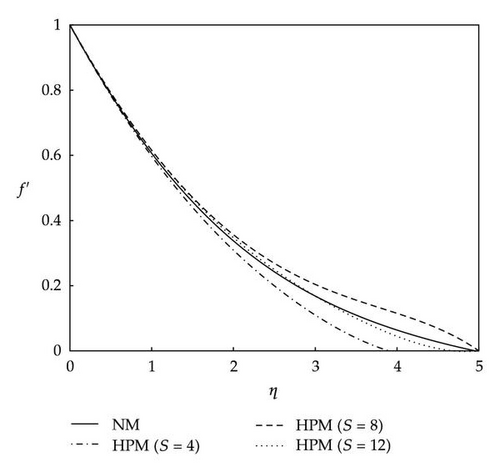
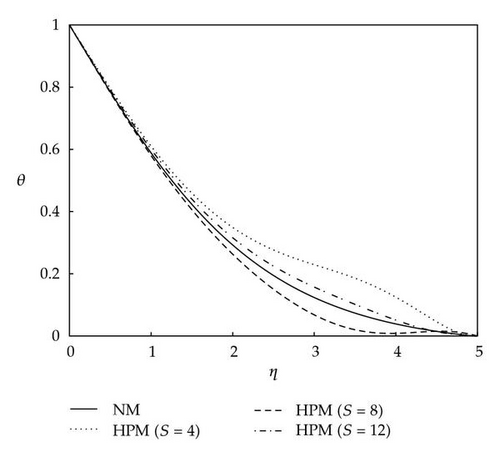
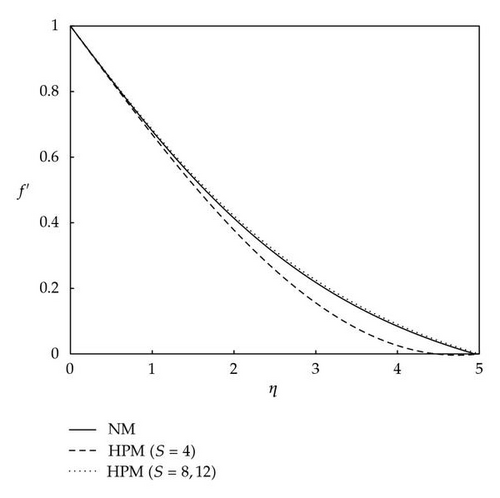
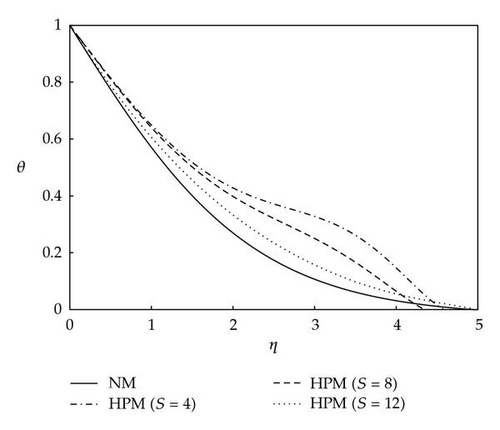
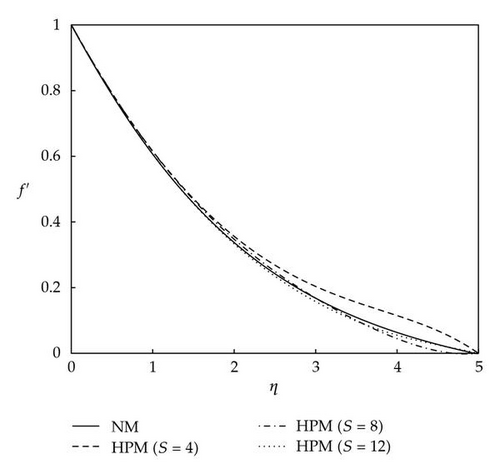

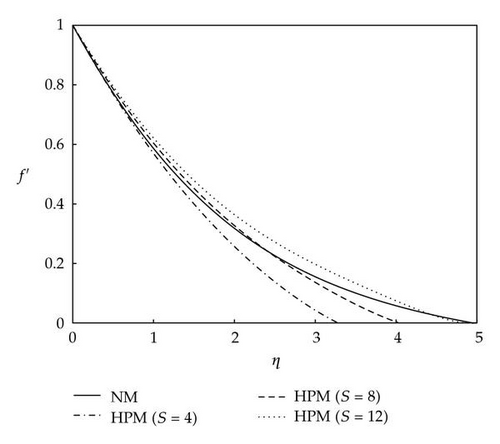
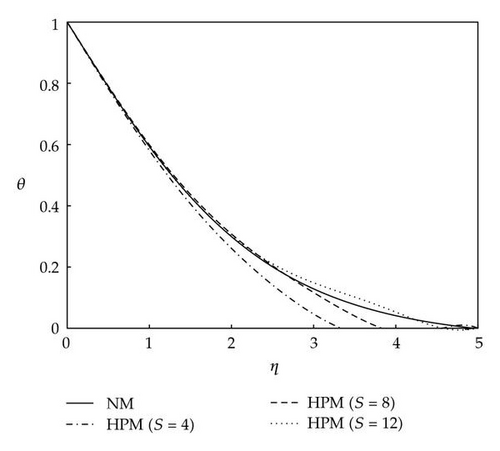
7. Conclusions
In this work, the nonlinear two-dimensional forced-convection boundary-layer magneto hydrodynamic (MHD) incompressible flow of nanofluid over a horizontal stretching flat plate with variable magnetic field including the viscous dissipation effect is solved using the homotopy perturbation method (HPM). The results are justified and compared with the results obtained from the numerical method (NM). Our results obtained from the HPM, when the number of sums of terms in the HPM series solution increases, showed a monotonic convergence towards the results using the NM. The results obtained from the HPM show at most less than 8% mean deviations when compared with the results obtained from the NM. For the nonlinear MHD problem, this is encouraging because these results are only achieved by including at most S = 12 number of sums of terms in the HPM series solution.
Nomenclature
-
- B(x):
-
- Magnetic field
-
- b:
-
- Constant parameter
-
- Ec:
-
- Eckert number
-
- :
-
- Thermal capacitance of solid
-
- :
-
- Thermal capacitance of fluid
-
- f:
-
- Dimensionless velocity variable
-
- ks:
-
- Thermal conductivity of nanoparticles
-
- kf:
-
- Thermal conductivity of fluid
-
- m:
-
- Index of power law velocity
-
- Mn:
-
- Magnetic parameter
-
- Pr:
-
- Prandtl number
-
- Re:
-
- Reynolds number
-
- S:
-
- No. of terms in the HPM
-
- T:
-
- Absolute temperature
-
- T∞:
-
- Constant temperature of the fluid far away from the plate
-
- Tw:
-
- Given temperature at the plate
-
- u:
-
- Velocity in x-direction
-
- v:
-
- Velocity in y-direction
-
- uw:
-
- Velocity of the plate
-
- x:
-
- Horizontal coordinate
-
- y:
-
- Vertical coordinate.
-
- Greek Symbols: σ:
-
- Electrical conductivity
-
- θ:
-
- Dimensionless temperature
-
- ψ:
-
- Stream function
-
- μf:
-
- Fluid viscosity
-
- φ:
-
- Nanoparticles volume fraction
-
- ρs:
-
- nanoparticles density
-
- ρf:
-
- Fluid density.




